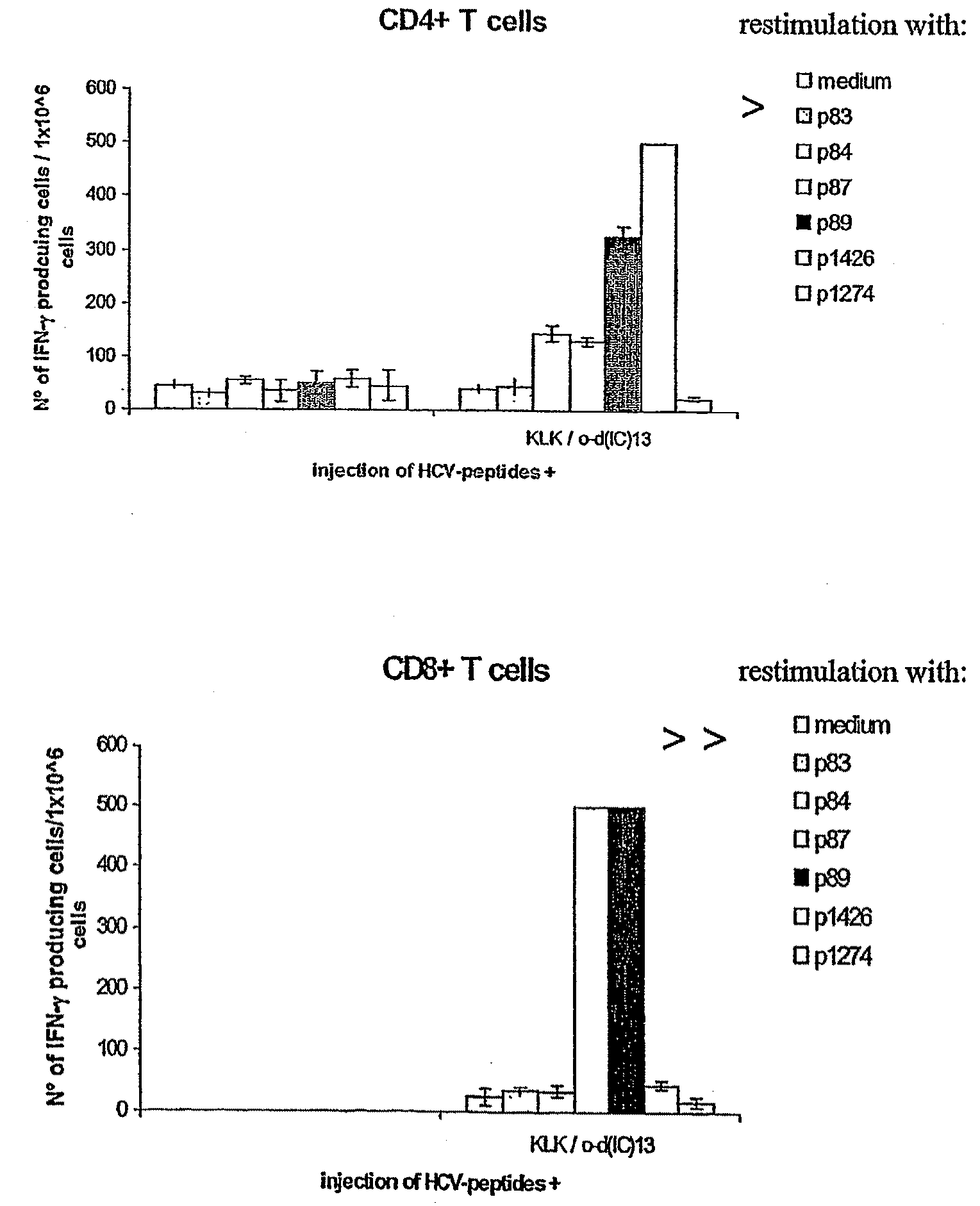Hcv vaccines
a technology of hcv and vaccine, which is applied in the field of hcv vaccines, can solve the problems of high false-positive and false-negative rate of computer algorithms for predicting t-cell epitopes, and achieve the effect of prolonging the shelf life of peptide mixtures and being useful and effectiv
- Summary
- Abstract
- Description
- Claims
- Application Information
AI Technical Summary
Benefits of technology
Problems solved by technology
Method used
Image
Examples
example i
Binding of HCV Derived Peptides to HLA Class II Molecules
[0096]According to the WO04 / 024182, several new peptides incorporating sequences from overlapping reactive HCV peptides or avoiding critical residues like cystein were synthesised. These were retested for their affinities to class II soluble HLA molecules, and results were compared to those obtained with the original (Table 1).
TABLE 1Binding of selected HCV-derived peptides and their 15-mercounterparts to soluble HLA class II moleculesPeptideIDHLA-DRB1*SEQBinding to solubleSEQIDPeptide sequences01010401040407011101NO:1798 IGLGKVLVDILAGYGAGVAGALVAFK−−++++ / −70B84GSIGLGKVLVDILAG+++−55B86 IGLGKVLVDILAGYG++++++ / −69B88 LGKVLVDILAGYGAG++++81B92 LVDILAGYGAGVAGA+−88B94 DILAGYGAGVAGALV+−−−18B96 LAGYGAGVAGALVAF++++−+ / −+ / −771799 AAWYELTPAETTVRLR+++++−+ / −4B46AGAAWYELTPAETTV+++++++++−+ / −6B48 AAWYELTPAETTVRL+++++++++−+ / −31827TAYSQQTRGLLG++−+ / −++115C114TAYSQQTRGLLGCIV++++ / −+ / −+++1161829 SMSYTWTGALITP+−−++ / ...
example ii
Identification and Characterisation of HCV-Epitope Hotspots
[0098]As outlined above, a T-cell epitope hotspot (a “hotspot”) is defined as a short peptide sequence at least comprising more than one T-cell epitope. For example, two or more epitopes may be located shortly after each other (shortly being defined as less than 5-10 amino acids), or directly after each other, or partially or even fully over-lapping. Hotspots may contain only class I or class II epitopes, or a combination of both. Epitopes in hotspots may have different HLA restrictions.
[0099]Due to the highly complex and selective pathways of class I and class II antigen processing, referred to in the introduction, T-cell epitopes cannot be easily predicted within the sequence of a polypeptide. Though widely used, computer algorithms for T-cell epitope prediction have a high rate of both false-negatives and false-positives.
[0100]Thus, as even individual T-cell epitopes are not obvious within the sequence of a polypeptide, t...
example iii
HCV Epitope Hotspot Ipep 1426 Contains at Least HLA-A*0201 and Several Promiscuous Class II T-Cell Epitopes
[0104]The major objective of this experiment was to compare the immunogenicity of the “hotspot” Ipep 1426, which contains at least one HLA-A*0201 epitope (Ipep 1334) and 2 promiscuous class II epitopes (Ipeps 1006 and 1425), to the individual epitopes. To this end peripheral blood mononuclear cells (PBMC) from several healthy HLA-typed blood donors were stimulated in vitro either with 1426 or a mixture of 1334, 1006, 1425. Three rounds of stimulation were performed resulting in oligoclonal T cell lines. Then, responses against all four peptides were assessed by interferon-gamma (IFN-γ) ELIspot analysis.
[0105]Peptide 1426, induces T cell responses similarly well as individual epitopes comprised within its sequence. In particular, CD8 positive T cells directed against the HLA-A*0201 restricted epitope 1334 were successfully generated.
TABLE 3peptide induced IFN-γ secretion of olig...
PUM
| Property | Measurement | Unit |
|---|---|---|
| Fraction | aaaaa | aaaaa |
Abstract
Description
Claims
Application Information
 Login to View More
Login to View More - R&D
- Intellectual Property
- Life Sciences
- Materials
- Tech Scout
- Unparalleled Data Quality
- Higher Quality Content
- 60% Fewer Hallucinations
Browse by: Latest US Patents, China's latest patents, Technical Efficacy Thesaurus, Application Domain, Technology Topic, Popular Technical Reports.
© 2025 PatSnap. All rights reserved.Legal|Privacy policy|Modern Slavery Act Transparency Statement|Sitemap|About US| Contact US: help@patsnap.com



